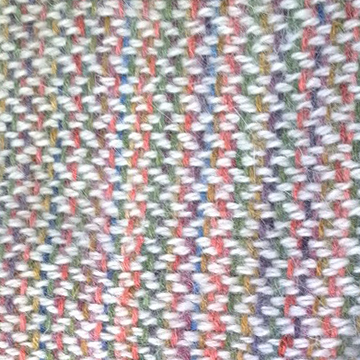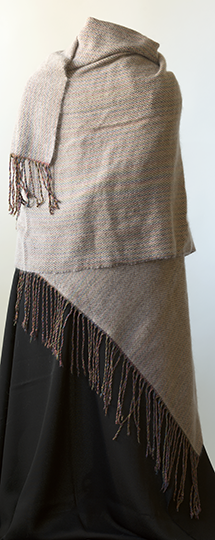Weaving with Angora
Marcy Petrini
August, 2017
A little while back I wanted to weave a shawl that would be light and airy for a good friend who had admired a similar shawl I had woven; my shawl had been made with a silk warp and a 100% polyamide knitting yarn weft that sadly was not longer available.
I had traveled with my friend to her native Portugal, so I wanted to incorporate that experience in her shawl; I had a yarn that I thought would be perfect for the warp: Silky by Prism Yarns, dyed for HGA’s Convergence® 2008 in Tampa Bay; it is multicolor dark pastels that remind me of the colors of the house fronts in Lisbon. Silky is 75% rayon and 25% silk. The yarn has about 180 yards/oz.

For weft I thought 100% angora would be perfect. I was surprised how hard it was to find enough 100% angora for a 36” wide, 90” long shawl in light grey. I had to settle for a beige called “fawn”. It ended up working fine with the warp colors which tend to be toward a warm palette.
In buying the weft, since it’s a knitting yarn, there was no mention of wraps per inch, but each ball has 49 yards. So I bought 35 balls, which sounds like a lot, but that’s only 1,715 yards. I knew that I would use 1,763 yards of warp (sett at 15 epi), so I wanted to be safe. It turned out that the angora is 140 yards / oz.
With the multicolor warp and the fuzzy weft, I didn’t want any additional design elements, but I did want the drape of a twill. I used a broken twill to avoid the pattern.
The simplest broken twill comes from a straight twill that has been “broken”, by switching the order, either in the threading or in the tie-up / treadling. The patterns for the two options are turned, as you can see from the drawdowns below:

Click here for the full-sized draft (a PDF will open in a new window).

Click here for the full-sized draft (a PDF will open in a new window).
I used the straight twill threading and I “broke” the tie-so I can weave a straight treadling as shown in the second drawdown above. It’s my favorite way to break a twill; I like to switch the two middle treadles, which allows me to avoid floating selvages, since the beginning and the end of the treadling sequence is the same as a straight twill and the outer threads are caught if the threading starts on an odd shaft and ends in an even shaft (or vice versa).
When I am not familiar with a yarn, I like to try to weave what looks right by eye, continue for a few inches and determine whether the beat is appropriate for the hand I want for the fabric. Then I measure and try to keep to that beat throughout. For this shawl my beat was 11 – 12 ends per inch. Below is a picture of the fabric.

And of the shawl:

I used 21 balls, which means that I had 14 left or 686 yards, not quite enough for another shawl, but maybe…. Read next month’s blog to find out what happened!
Please email comments and questions to
